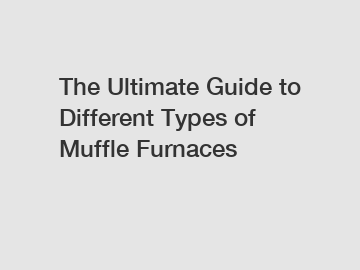The Ultimate Guide to Different Types of Muffle Furnaces
Apr. 07, 2024
Are you a scientist, researcher, or technician looking for the ultimate guide to different types of muffle furnaces? Well, look no further! In this comprehensive blog post, we will explore the various types of muffle furnaces available on the market today, their uses, and key features to consider when choosing the right furnace for your needs.
What is a Muffle Furnace?
Before we delve into the different types of muffle furnaces, let's start by understanding what a muffle furnace is. A muffle furnace is a specialized type of oven that is used for high-temperature applications such as annealing, ashing, calcining, and sintering. These furnaces are designed to heat materials to extreme temperatures while controlling the atmosphere inside the furnace.

Muffle furnaces have a heating chamber that is surrounded by insulation to maintain high temperatures and provide uniform heating. The heating element, typically made of ceramic or metal, heats the chamber to the desired temperature, while the muffle (or outer shell) protects the heating element and materials from direct contact.
Types of Muffle Furnaces.
1. Box Furnaces.
Box furnaces are the most common type of muffle furnace and are widely used in research laboratories, industrial settings, and educational institutions. These furnaces have a rectangular heating chamber with a front-loading door for easy access to the materials being heated. Box furnaces are versatile and can reach temperatures up to 1800°C, making them suitable for a wide range of applications.
2. Tube Furnaces.
Tube furnaces are another popular type of muffle furnace that is commonly used for heating materials in a controlled atmosphere. These furnaces have a cylindrical heating chamber with a horizontal or vertical orientation. Tube furnaces are ideal for applications that require continuous heating or processing of long, uniform materials such as wires, tubes, or rods.
3. Split Furnaces.
Split furnaces are designed with a two-piece design, allowing for easy loading and unloading of materials. These furnaces are ideal for applications that require frequent access to the heating chamber or for processing larger materials that may not fit in a traditional box furnace. Split furnaces are available in various sizes and temperature ranges to accommodate a wide range of applications.
4. Rotary Hearth Furnaces.
Rotary hearth furnaces are specialized muffle furnaces that are used for continuous processing of materials in a production setting. These furnaces have a rotating hearth that moves materials through the heating chamber for uniform heating and processing. Rotary hearth furnaces are commonly used in industries such as metallurgy, ceramics, and electronics for sintering, annealing, and heat treating.
Key Features to Consider.
When choosing a muffle furnace for your application, there are several key features to consider to ensure you select the right furnace for your needs:
1. Temperature Range: Consider the temperature range of the furnace to ensure it can reach the desired temperature for your application.
2. Heating Element: Choose a furnace with a high-quality heating element, such as ceramic or metal, for efficient and reliable heating.
3. Control System: Look for a furnace with a user-friendly control system that allows you to set and monitor the temperature, time, and other parameters.
4. Insulation: Insulation is essential for maintaining high temperatures and ensuring uniform heating throughout the chamber.
5. Safety Features: Consider furnaces with safety features such as overheat protection, door interlocks, and emergency shut-off to prevent accidents and ensure user safety.
Conclusion.
In conclusion, muffle furnaces are essential equipment for high-temperature applications in research, industry, and education. By understanding the different types of muffle furnaces available and key features to consider, you can choose the right furnace for your specific needs. Whether you require a box furnace for versatile applications or a tube furnace for continuous heating, there is a muffle furnace to suit your requirements. Trust in the expertise and experience of furnace manufacturers to help you select the ultimate muffle furnace for your application.
If you are looking for more details, kindly visit Athmosphere Furnace, Vacuum Heat Treating Furnaces, Vacuum Tempering Furnace.
170
0
0

Comments
All Comments (0)